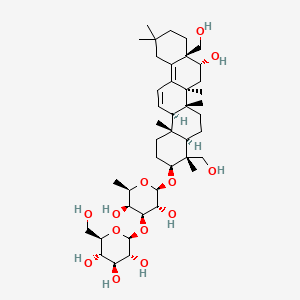

1. Saikosaponin A
2. Saikosaponin B
3. Saikosaponin B1
4. Saikosaponin B3
5. Saikosaponin B4
6. Saikosaponin C
7. Saikosaponin D
8. Saikosaponin K
9. Saikosaponin L
10. Saikosaponins
1. 58316-41-9
2. Saikosaponinb2
3. (2s,3r,4s,5s,6r)-2-[(2r,3r,4s,5s,6r)-2-[[(3s,4r,4ar,6ar,6bs,8r,8as,14ar,14bs)-8-hydroxy-4,8a-bis(hydroxymethyl)-4,6a,6b,11,11,14b-hexamethyl-1,2,3,4a,5,6,7,8,9,10,12,14a-dodecahydropicen-3-yl]oxy]-3,5-dihydroxy-6-methyloxan-4-yl]oxy-6-(hydroxymethyl)oxane-3,4,5-triol
4. Schembl7523565
5. Chembl3792981
6. Chebi:183954
7. Hy-n0248
8. S9303
9. Zinc85643336
10. Akos037514824
11. Ccg-270463
12. Cs-0008279
13. 316s419
14. A869478
15. Q-100669
16. Q63395661
17. (3b,4a,16a)-16,23,28-trihydroxyoleana-11,13(18)-dien-3-yl-6-deoxy-3-o-beta-d-glucopyranosyl-beta-d-galactopyranoside
| Molecular Weight | 781.0 g/mol |
|---|---|
| Molecular Formula | C42H68O13 |
| XLogP3 | 2.5 |
| Hydrogen Bond Donor Count | 9 |
| Hydrogen Bond Acceptor Count | 13 |
| Rotatable Bond Count | 7 |
| Exact Mass | 780.46599222 g/mol |
| Monoisotopic Mass | 780.46599222 g/mol |
| Topological Polar Surface Area | 219 Ų |
| Heavy Atom Count | 55 |
| Formal Charge | 0 |
| Complexity | 1500 |
| Isotope Atom Count | 0 |
| Defined Atom Stereocenter Count | 19 |
| Undefined Atom Stereocenter Count | 0 |
| Defined Bond Stereocenter Count | 0 |
| Undefined Bond Stereocenter Count | 0 |
| Covalently Bonded Unit Count | 1 |
Anti-Inflammatory Agents, Non-Steroidal
Anti-inflammatory agents that are non-steroidal in nature. In addition to anti-inflammatory actions, they have analgesic, antipyretic, and platelet-inhibitory actions. They act by blocking the synthesis of prostaglandins by inhibiting cyclooxygenase, which converts arachidonic acid to cyclic endoperoxides, precursors of prostaglandins. Inhibition of prostaglandin synthesis accounts for their analgesic, antipyretic, and platelet-inhibitory actions; other mechanisms may contribute to their anti-inflammatory effects. (See all compounds classified as Anti-Inflammatory Agents, Non-Steroidal.)
Antineoplastic Agents, Phytogenic
Agents obtained from higher plants that have demonstrable cytostatic or antineoplastic activity. (See all compounds classified as Antineoplastic Agents, Phytogenic.)
Antiviral Agents
Agents used in the prophylaxis or therapy of VIRUS DISEASES. Some of the ways they may act include preventing viral replication by inhibiting viral DNA polymerase; binding to specific cell-surface receptors and inhibiting viral penetration or uncoating; inhibiting viral protein synthesis; or blocking late stages of virus assembly. (See all compounds classified as Antiviral Agents.)
Immunosuppressive Agents
Agents that suppress immune function by one of several mechanisms of action. Classical cytotoxic immunosuppressants act by inhibiting DNA synthesis. Others may act through activation of T-CELLS or by inhibiting the activation of HELPER CELLS. While immunosuppression has been brought about in the past primarily to prevent rejection of transplanted organs, new applications involving mediation of the effects of INTERLEUKINS and other CYTOKINES are emerging. (See all compounds classified as Immunosuppressive Agents.)